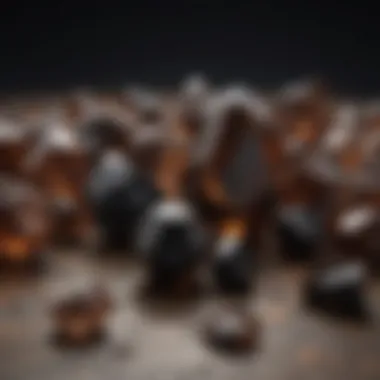Exploring Black Crystals with Brown Lines


Intro
Black crystals with brown lines present a compelling area of study, blending science, geology, and hobbyist fascination. These formations are intriguing due to their distinctive appearance and unique properties. Their mineral composition tells a story of geological processes, making them significant in both natural and collectible realms. Understanding these crystals can open doors to appreciating their aesthetic and practical values.
As collectors seek to expand their collections, recognizing, identifying, and delving deeper into their significance becomes essential. This exploration highlights key components, including geological formation, the intricate beauty of their aesthetics, and practical applications.
Featured Collectible of the Month
Overview
Black crystals with brown lines are often characterized by their dark base colors adorned with striking streaks of brown. This visual contrast creates a captivating display that appeals to collectors. They can be found in a variety of settings, from mines to markets, and their rarity adds to their allure.
Collectors often look for specific features, such as the clarity of the lines, the uniformity of the dark color, and the overall condition of the crystals. Such factors contribute to their value in the market. Keeping abreast of current trends in what is collectible drives interest and enthusiasm.
Historical Significance
The historical context of black crystals with brown lines is rich and diverse. They have been used for thousands of years across various cultures for both decorative and practical uses. In some traditions, these crystals were believed to hold protective or healing properties.
In modern times, their significance has shifted toward appreciation as unique specimens within the mineral community. Collectors often come to value not only their physical beauty but also their stories, tying them back to ancient cultures or geological phenomena. Some notable regions where these crystals are sourced include Brazil and Madagascar.
"Black crystals with brown lines often serve as a bridge between nature and human experience, embodying both aesthetic appeal and historical depth."
Identification Techniques
Visual Characteristics
Identifying black crystals with brown lines can be straightforward. Collectors should focus on the following visual clues:
- Color: Look for a deep black that contrasts sharply with the brown lines or streaks. The lines should be distinct and well defined.
- Clarity: Evaluate the transparency of the crystal. High-quality examples will have minimal inclusions.
- Surface Texture: Check for smooth surfaces, which often indicate better quality. Rough surfaces might suggest lower-grade specimens.
Resources for Identification
For enthusiasts and novices alike, utilizing proper resources is vital for accurate identification. Recommended sources include:
- Online forums such as Reddit where collectors share tips and experiences.
- Reference sites like Wikipedia and Britannica which offer valuable insights into mineral properties.
- Local mineral shops or club meetings which can provide hands-on experience and further guidance.
Intro to Black Crystals with Brown Lines
The exploration of black crystals featuring brown lines presents a unique interest within geology as well as the field of mineral collecting. These formations hold much more than aesthetic appeal; they are repositories of the Earth's history and offer intriguing insights into the environmental changes over time. Understanding these crystals requires examining their formation, composition, and significance across different cultures and scientific domains.
Crystals, particularly those with distinct colorations and patterns, act as a bridge between our natural world and human experiences. Black crystals with brown lines, in particular, capture attention due to their striking appearance and the stories they tell. Each crystal's unique characteristics can serve as an educational tool for both novices and seasoned collectors, promoting a deeper appreciation for the natural processes that lead to their creation. As such, this article endeavors to illuminate various aspects, including the geological processes involved in their formation, their cultural contexts, and methods for identification and collection.
In light of these points, the significance of black crystals with brown lines extends beyond mere visual allure. This article seeks to engage the reader with comprehensive examinations and insights into this fascinating topic.
Geological Formation of Black Crystals
Understanding the geological formation of black crystals with brown lines is crucial for grasping their unique characteristics and properties. This section will delve into the underlying mineral composition and the environmental conditions that contribute to the formation of these intriguing formations. By examining these elements, collectors and enthusiasts can appreciate the complexity and significance of their crystal collections.
Mineral Composition
The mineral composition of black crystals with brown lines is a defining aspect that influences their appearance and characteristics. These crystals often include minerals such as quartz, tourmaline, or biotite, among others. Notably, the dark color of the crystals generally stems from the presence of iron and other transition metals. These elements absorb certain light wavelengths, resulting in the rich, dark hues that collectors find appealing.
The brown lines that may appear in conjunction with the predominantly black surface can arise from various factors. There might be different mineral inclusions or impurities that create these lines during the crystal's growth phase. These subtle variations can also reflect the geological conditions under which the crystals formed. Different forms of the same mineral can exhibit unique patterns that enhance their aesthetic value.


Examining the microscopic structure of these minerals reveals their intricate internal compositions. Techniques such as thin section petrography can illuminate how the minerals interact within the crystal lattice. This level of detail not only aids in identification but also enriches the narrative behind each specimen collected.
Environmental Conditions for Formation
The environmental conditions under which black crystals with brown lines form are equally important. These crystals typically crystallize in specific geological environments, often found in igneous or metamorphic rock formations. Factors such as temperature, pressure, and the chemical environment play significant roles.
High temperatures paired with specific pressure conditions can lead to the formation of larger and more distinctive crystals.
- In igneous environments, rapid cooling can result in smaller crystals with unique characteristics, while slower cooling often enables larger formations.
- Metamorphic processes, on the other hand, involve the alteration of existing rock under heat and pressure, leading to additional mineral growth or the formation of new minerals.
Furthermore, the availability of silica, alumina, and iron influences the crystal structure during formation. The variations in mineral content and environmental conditions contribute to the diverse range of black crystals with brown lines that can be found globally.
"The balance of environmental elements will determine not only the size and shape of the crystals but also their beauty and complexity."
In summary, knowledge of mineral composition and environmental conditions enhances the understanding and appreciation of black crystals with brown lines. Collectors can make informed decisions when acquiring such specimens, ensuring their collections are both diverse and meaningful.
Identification Methods
Understanding how to identify black crystals with brown lines is crucial for collectors and enthusiasts alike. Proper identification not only enhances the appreciation of these crystals but also aids in categorizing them within the vast geological and collectible frameworks. Methods of identification blend observational techniques with tools that can better highlight their unique properties.
Visual Inspection Techniques
Visual inspection remains the most accessible approach for identifying black crystals with brown lines. Collectors should develop an eye for specific characteristics that differentiate these crystals from similar specimens. Look for the distinct brown lines — their width, orientation, and pattern can all offer clues about the mineral's identity. Furthermore, evaluating the surface texture is essential. Some crystals might exhibit smooth surfaces while others may appear more rugged or fibrous. The color intensity can also vary; thus, comparing the specimen in different lighting conditions is advisable.
Certain key elements contribute to the effectiveness of visual inspection:
- Lighting conditions: Natural light often provides the best view.
- Background contrast: Using a contrasting background can enhance visibility of features.
- Familiarization with varieties: Knowledge of similar-looking crystals helps avoid confusion.
Using Tools for Identification
Tools can play a significant role in refining the identification process. They allow a deeper analysis beyond what is observable by the naked eye.
Magnification Devices
Magnification devices, such as hand lenses or microscopes, are valuable for examining black crystals closely. Magnification reveals intricate details that are often hard to distinguish unaided. Characteristics like internal inclusions, striations, or surface markings become apparent with magnified views. This clarity improves the accuracy of identification drastically.
A principal advantage of using magnification devices is their ability to uncover underlying features. For example, the way light interacts with the crystal's structure can highlight differences in composition that are otherwise invisible. However, one limitation is the need for steady hands and proper lighting to avoid distortion of the view. Despite this, their popularity among collectors solidifies their role in identification.
Identifying Patterns and Striations
Identifying patterns and striations on black crystals serves to provide insight into their geological history and formation processes. Patterns may tell stories of the environment from which the crystal originated while striations can indicate growth processes or enhanced mineral composition. It is essential to note that each crystal may exhibit unique characteristics.
Key features of pattern and striation identification include:
- Orientation of lines: Directional patterns can suggest how crystals formed under specific environmental conditions.
- Regularity vs. irregularity: Regular patterns might point to a more stable formation environment, while irregularity could indicate turbulent geological processes.
The strengths of using these techniques lie in identifying authenticity and origin. However, these methods often require experience as similar patterns can occur across different species. Therefore, developing a skill set in recognizing these subtle differences should be a priority for any serious collector.
Recognition and identification of black crystals with brown lines require both keen observation and the appropriate tools to enhance understanding. The process opens avenues to appreciate the natural formation of these unique geological wonders.
Collecting Black Crystals
Collecting black crystals with brown lines can be a rewarding endeavor. These unique formations capture the interest of many enthusiasts and hobbyists. The process of collecting involves several important considerations that add depth to the experience. Understanding what makes these crystals distinct can enhance both the collecting journey and the appreciation of these geological wonders.


Starting Your Collection
Initiating a collection of black crystals requires careful thought and planning. First, one should educate oneself on the various types of black crystals available. Common examples include obsidian, black tourmaline, and black garnet, each featuring distinct characteristics and geological origins. Observing these crystals in nature or in collections can provide invaluable insights.
To start, one might visit local rock and mineral shows or join clubs that focus on crystal collecting. Engaging with seasoned collectors can also provide tips on where to find black crystals and how to verify their authenticity. Using a microscope or hand lens to examine potential pieces can help determine if they have the desired characteristics. It is advisable to keep a well-organized log of collected specimens, noting their source and any interesting facts related to their formation.
Ethical Considerations in Collecting
Ethics play a crucial role in the collecting process. Responsible collectors should prioritize the preservation of natural habitats. Over-collecting in certain areas can lead to significant damage to the environment. It is imperative to follow the local regulations regarding collection, especially in protected areas.
"Preservation of natural resources is essential for future generations to enjoy the beauty of our planet."
Moreover, it is wise to avoid purchasing crystals from dubious sources. Always ask about the origin of the specimens, as black crystals may be harvested from ethically questionable sites. Joining ethical collector networks can help ensure that your collecting habits are sustainable and responsible.
By starting a collection thoughtfully and ethically, collectors not only expand their personal treasures but also contribute positively to the geology community. Engaging in responsible collecting fosters a deeper understanding of these fascinating formations and encourages a culture of respect for our natural resources.
Care and Preservation Techniques
Caring for black crystals with brown lines is essential for maintaining their beauty and integrity. Collectors often overlook the necessity of proper care, which can lead to damage over time. Understanding how to clean and protect these crystals not only enhances their appearance but also prolongs their lifespan as valuable collectibles.
Cleaning and Maintenance Tips
Cleaning your black crystals should be a regular part of your maintenance routine. It is crucial to use gentle methods to avoid scratching or damaging the surface. Here are some effective cleaning tips:
- Use Soft Materials: Always opt for a soft cloth or a brush with soft bristles. Avoid abrasive materials that can cause scratches.
- Mild Soap Solution: For deeper cleaning, mix a few drops of mild soap with warm water. Dip the soft cloth into this solution and gently wipe the crystal. Make sure to rinse with clean water to remove any soap residue.
- Avoid Harsh Chemicals: Using bleach or other harsh chemicals can lead to discoloration. Stick to natural cleaning agents.
- Drying Process: After cleaning, allow the crystals to air dry completely. Avoid direct sunlight as it can fade colors over time.
By following these cleaning tips, collectors can ensure their black crystals remain in optimal condition, retaining their unique features.
Storage Solutions for Longevity
Proper storage is vital in preserving black crystals with brown lines. This prevents damage from environmental factors and accidental impact. Here are recommended storage solutions:
- Use Individual Cases: Store each crystal in its own case. This will prevent them from scratching against each other. Clear acrylic boxes are a popular choice, as they protect while allowing visibility.
- Control Humidity: Store crystals in a place with stable humidity levels. Excess moisture can lead to mold growth or damage.
- Avoid Direct Sunlight: Prolonged exposure to sunlight can fade the colors. Place the crystals in a shaded area or store them in a drawer or cabinet.
- Use Cushioning: For added protection, line your storage cases or boxes with soft fabric or foam. This can absorb shocks and keep the crystals secure.
Remember that long-term preservation relies not just on how you store the crystals, but also on how you handle them. Always lift them with care and store them properly after each use.
By focusing on cleaning and appropriate storage, collectors can ensure that their black crystals with brown lines will remain a cherished part of their collection for years to come.
Applications and Uses of Black Crystals
The exploration of black crystals with brown lines extends beyond mere aesthetics. These unique formations hold significance across various fields, from industrial applications to their role in the fossil and collectible markets. Understanding their uses allows enthusiasts to appreciate their value deeply. This segment will explore the practical applications of these crystals, providing insight into their importance in the contemporary market.
Industrial Applications
Black crystals with brown lines are not just sought after by collectors; they also serve several vital industrial functions. These applications derive from their specific mineral compositions and physical properties. Some of the notable uses include:
- Electronic Components: Certain black crystals are used in the manufacturing of semiconductors and capacitors. Their unique properties allow for efficient energy transfer, which is crucial for electronic devices.
- Construction Materials: In the building industry, these crystals may be utilized as aggregate in concrete. Their strength and durability enhance the quality of construction, making them preferred choices in some commercial projects.
- Abrasives: Some variations of black crystals possess hardness that qualifies them as effective abrasives. They can surface finish materials or must be used in cutting tools.
- Pigments: The distinctive coloration of these crystals can be harnessed in producing pigments for paints and coatings. Their deep black hue combined with brown lines can create unique finishes in artistic and industrial applications.
"Understanding the industrial potential of black crystals expands their significance beyond the collector's shelf into practical applications that impact everyday manufacturing and technology."
These industrial uses not only highlight the functional aspects of black crystals but also contribute to their market value. As demand increases for both aesthetic and practical implementations, collectors may find opportunities for investment in this sector.
Fossil and Collectible Use


In the realm of collectibles, black crystals with brown lines offer a distinct appeal to enthusiasts. Their rarity and unique formations make them objects of desire among hobbyists and serious collectors alike. The following highlights key aspects of their collectible nature:
- Aesthetic Appeal: The striking contrast between the black body of these crystals and the brown lines creates visual intrigue. Collectors often seek specimens with unique patterns or particularly vivid examples, enhancing their display potential.
- Cultural Significance: Many collectors appreciate the historical and cultural contexts associated with black crystals. They may serve symbolic meanings across various cultures, which can elevate their value in the eyes of collectors.
- Educational Value: For rock and fossil collectors, these crystals provide an opportunity to explore geological processes. They can be used in educational settings to teach about mineral formation and classification.
- Investment Potential: Given their rising market trends, black crystals can represent a worthwhile investment. As more people turn to collecting as a hobby, the demand for unique specimens may lead to significant value appreciation over time.
Collectors should be cautious about market fluctuations and ethical considerations similar to those in other areas of collecting. Understanding the potential uses and significance of black crystals with brown lines can help foster informed collecting practices.
Market Value and Trends
The market for black crystals with brown lines demonstrates a dynamic interplay between collector demand, aesthetic appeal, and geological rarity. Understanding these trends helps collectors make informed decisions. Both novice and seasoned collectors benefit from insights into market fluctuations. This section explores the factors influencing value and highlights current trends, alongside predictions for future developments.
Factors Influencing Value
Several elements come into play when determining the market value of black crystals with brown lines:
- Rarity: The scarcity of a specific type significantly impacts its price. Those black crystals that are less common can command higher prices.
- Condition: Quality is paramount. Crystals with minimal flaws or damages typically attract better market prices.
- Market Trends: Shifts in collector interest can boost demand. A growing fascination with certain crystals or geological formations can lead to increased prices.
- Historical Significance: Provenance can enhance value. Crystals with a known history or that were previously owned by notable collectors often hold a premium.
These factors work together, shaping the marketplace and influencing how collectors perceive the worth of their acquisitions.
Current Market Trends and Predictions
In recent years, the market for black crystals with brown lines has shown some intriguing trends:
- Rising Collector Demand: There is a noticeable uptick in interest among collectors. This can be attributed to the unique aesthetic of these crystals and their appeal as decorative items.
- Online Sales Growth: The rise of online platforms like Facebook and Reddit has made acquiring these crystals much easier for collectors, expanding buyer access to various sources, thus affecting market dynamics.
- Sustainability Concerns: Eco-friendly collecting practices are becoming more prominent. As collectors focus on ethical sourcing, crystals sourced responsibly are likely to see increased value.
- Technological Advances: Improved methods of identification and analysis are helping collectors gain more confidence in their purchases, fostering a more knowledgeable base of enthusiasts.
In summary, understanding the market value and the evolving trends for black crystals with brown lines equips collectors with the necessary insights. This enables strategic decision-making. As the market continues to evolve, remaining adaptable to these changes is essential for anyone looking to invest or collect.
Scientific Significance
The study of black crystals with brown lines extends far beyond their aesthetic appeal. The scientific significance embodies a multidisciplinary approach that encompasses geology, environmental science, and even anthropology. These crystals can provide critical insights into the conditions under which they form, the processes that govern mineralogy, and their potential applications across various scientific fields.
Research and Studies Conducted
Research surrounding these unique formations has uncovered various interesting aspects. Numerous studies have been conducted, focusing on:
- Mineral Composition Analysis: Researchers have studied the various minerals that contribute to the formation of black crystals with brown lines. This includes examining their elemental makeup and understanding how each mineral affects the overall properties of the crystal.
- Geological Context: Various field studies have been undertaken to correlate the presence of these crystals to specific geological environments. Such research assists in understanding their distribution and implications for local geology.
- Chemical Behavior: Scientists analyze how these minerals react in different environmental conditions. Knowing their stability and reactivity can help predict future geological changes.
Findings from these studies are often published in scholarly articles and can be accessed in platforms like Britannica or Wikipedia.
Implications for Geology and Environmental Science
The implications of black crystals with brown lines in geology and environmental science are profound. Here are some aspects worth noting:
- Indicator of Geological Processes: These crystals serve as indicators of specific geological processes, such as metamorphism and sedimentation. Their presence can suggest the historical geological activity of a region.
- Environmental Monitoring: Scientists can use these minerals to monitor environmental changes. Their compositions may reflect past climatic conditions, providing clues to environmental shifts over time.
- Sustainability: The study of these crystals also contributes to the discussions surrounding sustainable extraction processes. Understanding mineral composition and formation can lead to more ethical mining practices that minimize ecological damage.
"The understanding of black crystals with brown lines offers a window into the earth's history and serves as a foundation for future research in both geology and environmental science."
In summary, the scientific significance of black crystals with brown lines cannot be overstated. These formations are not merely geological curiosities; they are invaluable tools for understanding our planet. Not only do they provide insights into mineralogy and geological processes, but they also have far-reaching implications for environmental studies. Collectors of these crystals can appreciate not just their beauty but also their role in the narrative of our earth's history.
Finale
Recap of Key Points
To summarize, the following key aspects were covered in this exploration:
- Definition and Characteristics: Black crystals with brown lines showcase distinct features that contribute to their aesthetic appeal and geological interest.
- Geological Formation: Ongoing research has pinpointed specific mineral compositions and environmental conditions necessary for forming these crystals.
- Identification Techniques: Both visual inspection and advanced tools aid collectors in accurately identifying these crystals.
- Care and Preservation: Proper cleaning and storage techniques ensure that these crystals maintain their allure for years to come.
- Market Trends: The fluctuating market value is influenced by various factors, from quality to demand in the collector community.
- Scientific Significance: The research surrounding these crystals opens doors to discussions about geology and environmental health.
Future Prospects and Closing Thoughts
Looking toward the future, it is evident that the study and appreciation of black crystals with brown lines will continue to evolve. Ongoing research can unveil new dimensions regarding their properties and formation, enhancing their significance in the natural world. As the collector community grows, there will likely be increased interest in sustainable practices related to their acquisition and preservation. The dialogue surrounding these crystals will undoubtedly deepen, providing opportunities for both enthusiasts and professionals to connect over shared knowledge.
As we delve into this fascinating subject, it becomes crucial to remain informed and engaged with the latest developments. The continued exploration of black crystals with brown lines is a testament to the rich intersection between science and passion for collecting.



